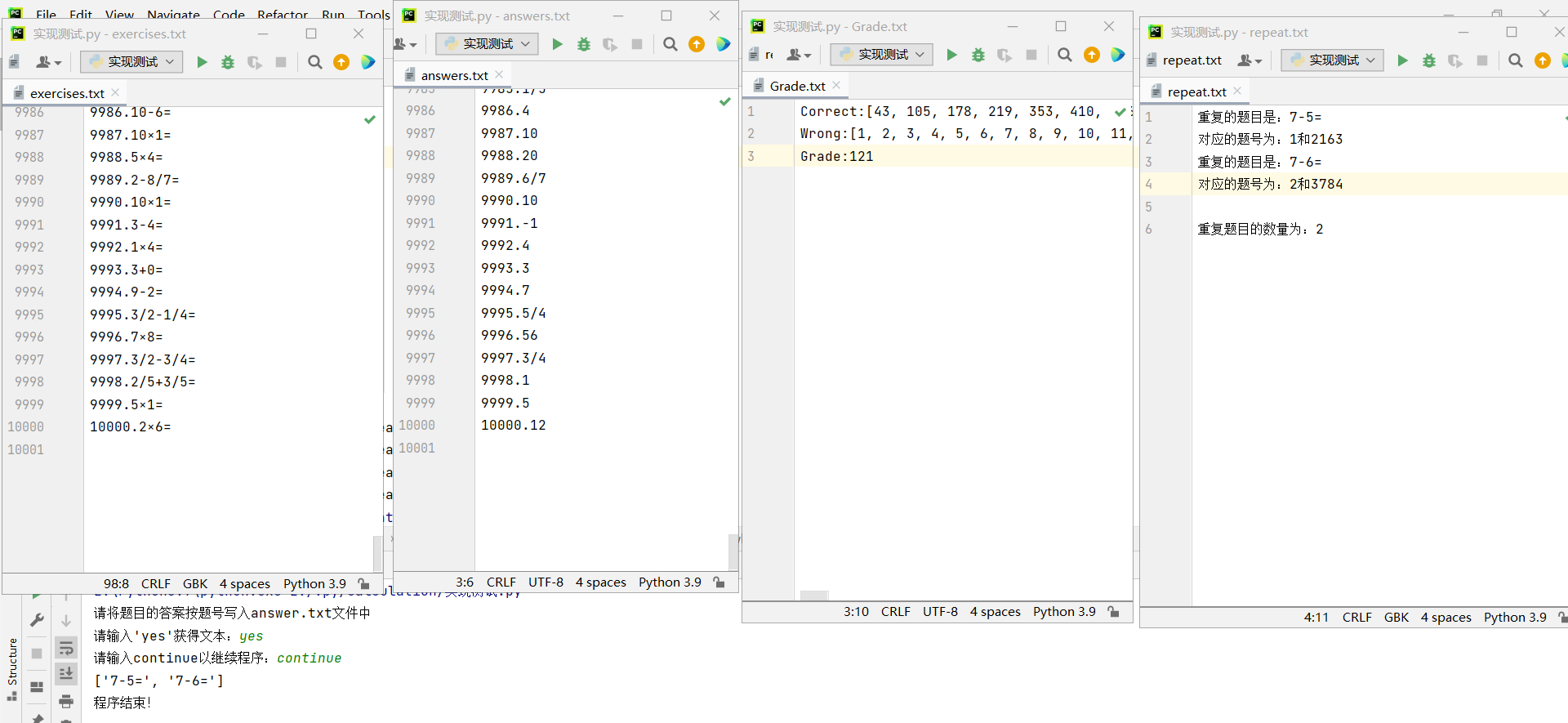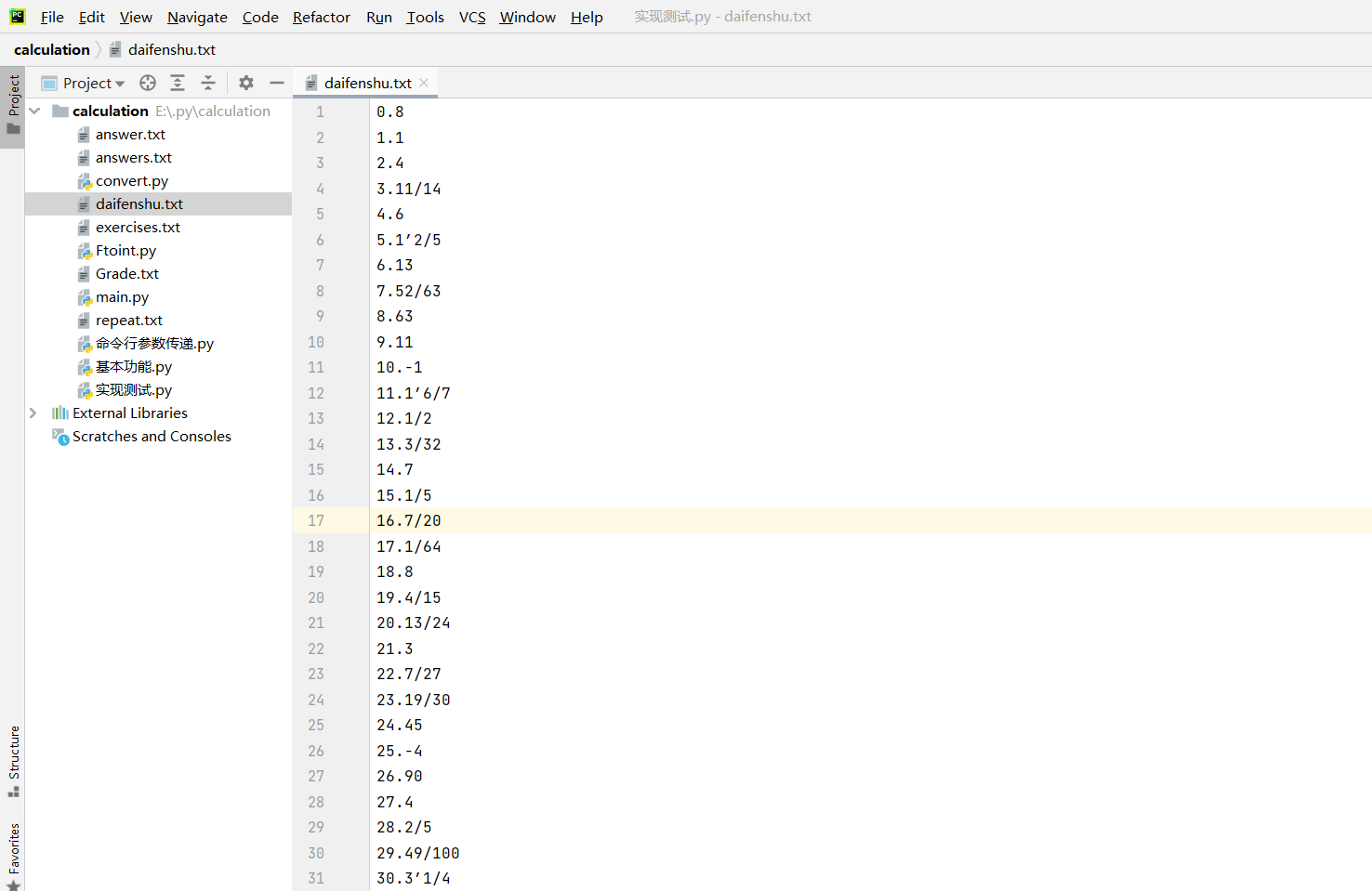2021-2022-1 20211420《信息安全专业导论》小学四则运算编程实践
设计思路
小学四则运算少不了自然数,符号,等号等等,所以需要将每一个功能都定义一个函数
代码
# 导入库并定义列表
import random
import fractions
questions = []
answers = []
#实现四则运算基本功能
def randomcalc(questions, answers):
symbol = random.choice(["+", "-", "×", "÷"])
if symbol == "+":
a = random.randint(0,10)
b = random.randint(0,10)
while a == b:
a = random.randint(0, 10)
b = random.randint(0, 10)
else:
questions.append(str(a) + '+' + str(b) + '=')
answers.append(a + b)
elif symbol == "-":
a = random.randint(0,10)
b = random.randint(0,10)
while a == b:
a = random.randint(0, 10)
b = random.randint(0, 10)
else:
questions.append(str(a) + '-' + str(b) + '=')
answers.append(a - b)
elif symbol == "×":
a = random.randint(0,10)
b = random.randint(0,10)
while a == b:
a = random.randint(0, 10)
b = random.randint(0, 10)
else:
questions.append(str(a) + '×' + str(b) + '=')
answers.append(a * b)
else:
a = random.randint(0, 10)
if a == 0:
b = random.randint(1, 10)
else:
b = random.randint(1, a+1)
while a == b:
a = random.randint(0, 10)
if a == 0:
b = random.randint(1, 10)
else:
b = random.randint(1, a + 1)
else:
questions.append(str(a) + '÷' + str(b) + '=')
answers.append(fractions.Fraction(a, b))
# 生成分数
def createfraction():
fenzi1 = random.randint(1, 10)
fenmu1 = random.randint(1, 10)
fenzi2 = random.randint(1, 10)
fenmu2 = random.randint(1, 10)
fraction1 = fractions.Fraction(fenzi1, fenmu1)
fraction2 = fractions.Fraction(fenzi2, fenmu2)
return fraction1, fraction2
# 两个分数四则运算(输出应为大于0的真分数)
def fractioncalc(questions, answers):
symbol = random.choice(["+", "-", "×", "÷"])
a, b = createfraction()
if symbol == "+":
while a+b>1:
a, b = createfraction()
while a == b:
a, b = createfraction()
else:
questions.append(str(a) + '+' + str(b) + '=')
answers.append(a + b)
elif symbol == "-":
a, b = createfraction()
a, b = max(a, b), min(a, b) # 防止出现负数
while a == b:
a, b = createfraction()
else:
questions.append(str(a) + '-' + str(b) + '=')
answers.append(a - b)
elif symbol == "×":
while a*b>1:
a, b = createfraction()
while a == b:
a, b = createfraction()
else:
questions.append(str(a) + '×' + str(b) + '=')
answers.append(a * b)
else:
while a/b>1:
if b == 0:
b += 1
else:
a, b = createfraction()
while a == b:
if b == 0:
b += 1
else:
a, b = createfraction()
else:
questions.append(str(a) + '÷' + str(b) + '=')
answers.append(fractions.Fraction(a, b))
# 输出函数
def output():
n = k = 10000 # 第一个while循环的n值会改变
m = 0
txt1 = open('exercises.txt', 'w+')
txt2 = open('answers.txt', 'w')
# 写入10000道题目
while n>0:
choice = random.choice([0, 1])
if choice == 0:
randomcalc(questions, answers)
else:
fractioncalc(questions, answers)
n -= 1
# 向两个文件中分别写入题目和答案
while m<k:
question = questions[m]
answer = answers[m]
txt1.write(str(m+1) + '.')
txt2.write(str(m + 1) + '.')
txt1.write(question)
txt2.write(str(answer))
txt1.write('\n')
txt2.write('\n')
m += 1
# 实现统计错题,判定对错以及计算得分的功能
def judge():
k = 10000
print("请将题目的答案按题号写入answer.txt文件中")
text = input("请输入\'yes'获得文本:")
if text == 'yes':
youranswer = open('answer.txt')
answers = open('answers.txt')
x = list(youranswer)
y = list(answers)
o = 0
C = 0
Correct = []
Wrong = []
while o < k:
if x[o] == y[o]:
t = o + 1
Correct.append(t)
else:
C += 1
p = o + 1
Wrong.append(p)
o += 1
Grade = k - C
G = open('Grade.txt', 'w')
G.write('Correct:')
G.write(str(Correct))
G.write('\n')
G.write('Wrong:')
G.write(str(Wrong))
G.write('\n')
G.write('Grade:')
G.write(str(Grade))
G.close()
# 判断重复题目数量
def repeatjudger():
repeatfile = open('repeat.txt', 'w')
repeater = input('请输入continue以继续程序:')
open('repeat.txt', 'w')
if repeater == 'continue':
repeat = []
repeatnum = 0
j = 0
for i in range(0, 10000):
while j < i:
if questions[i] == questions[j]:
repeatnum += 1
repeatq = questions[i]
repeat.append(questions[i])
repeatfile.write('重复的题目是:')
repeatfile.write(repeatq)
repeatfile.write('\n')
repeatfile.write('对应的题号为:')
repeatfile.write(str(j+1))
repeatfile.write('和')
repeatfile.write(str(i+1))
repeatfile.write('\n')
j += 1
else:
break
repeatfile.write('\n')
repeatfile.write('重复题目的数量为:')
repeatfile.write(str(repeatnum))
repeatfile.close()
print(repeat)
print("程序结束!")
代码运行

到这里基本已经实现任务目标,但是还有一些细节并没有处理得当。至于生成的题目数量,我这用的10000道题目,可以更多,也可以较少,只要你的计算机不会崩溃就能够运行。
增加带分数转化功能
# 实现答案的带分数转化
fractiontointlist = []
def fractiontoint():
i = 0
while i < 10000:
f = answers[i]
a=f.numerator #分子
b=f.denominator #分母
daifenshu = open('daifenshu.txt', 'w+')
if a%b==0: #为整数
fractiontointlist.append('%d'%(a/b))
daifenshu = open('daifenshu.txt', 'w+')
elif a<b: #为真分数
fractiontointlist.append('%d%s%d' % (a,'/',b))
daifenshu = open('daifenshu.txt', 'w+')
else: #为带分数
daifenshu = open('daifenshu.txt', 'w+')
c=(a-a%b)/b
a = a - c * b
fractiontointlist.append('%d%s%d%s%d' % (c,'’',a,'/',b))
i += 1
else:
print("将答案中的真分数转化为带分数成功")
time.sleep(1)
print("程序结束!")
daifenshu = open('daifenshu.txt', 'w+')
for i in range(10000):
data = fractiontointlist[i]
daifenshu.write(str(i)+'.')
daifenshu.write(data)
daifenshu.write('\n')
上面的函数就可以实现真分数转化带分数的功能了,结果如下图




